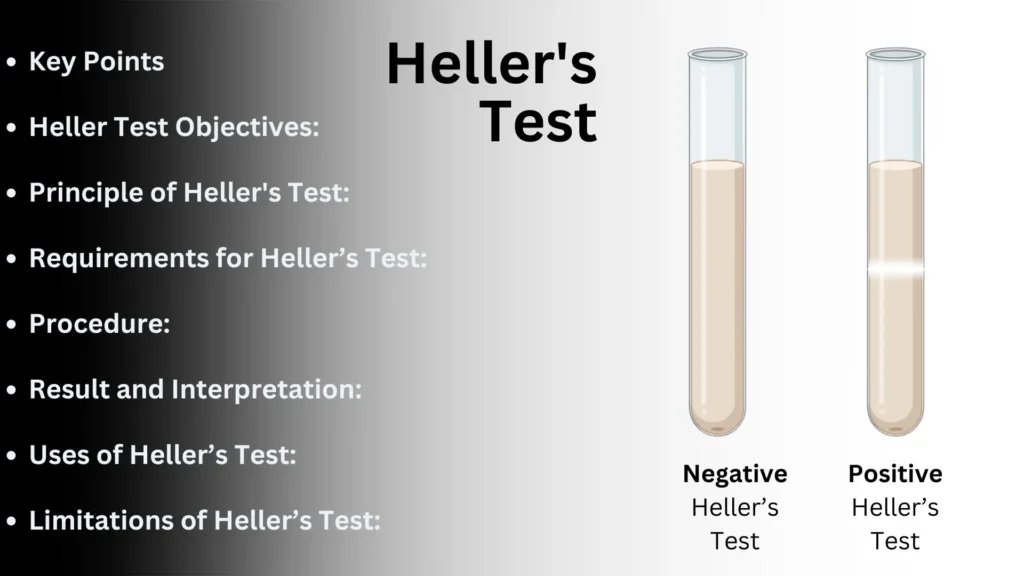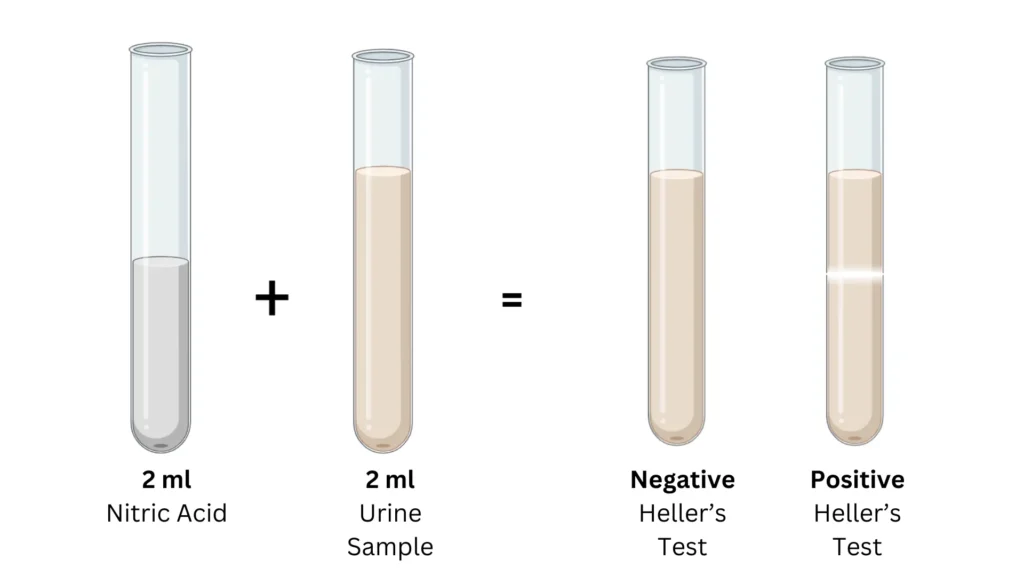Heller’s Test Purpose, Uses, Procedure, Limitations
The Heller’s test is a Biochemical Procedure that identifies proteins in a sample by denaturing them with strong acids. The Heller test typically uses concentrated nitric acid for protein denaturation. The test is performed for clinical purposes to detect abnormal proteins in biological fluids, including urine. The Heller test is a type of precipitation test in which precipitation occurs by denaturation.

The test was discovered and named after Austrian chemist Johann Florian Heller while he was studying the biochemical nature of urine. The most common proteins detected by the Heller test in urine include albumin and globulin. The test is clinically important because it is simple and requires minimal reagents. It also detects proteins in biological fluids that represent the pathological features of certain diseases, which helps in the diagnosis of diseases.
Key Points about Heller’s Test:
- Purpose: Detects proteins in biological fluids, mainly urine, through protein denaturation.
- Principle: Precipitation of proteins occurs by adding concentrated nitric acid, causing denaturation.
- Discovery: Developed by Austrian chemist Johann Florian Heller while studying urine biochemistry.
- Commonly Detected Proteins: Detects albumin and globulin in clinical samples.
- Procedure: Concentrated nitric acid is layered beneath the sample, forming a white precipitate if proteins are present.
- Type of Test: It is a precipitation test driven by protein denaturation.
- Clinical Significance: Used to diagnose conditions like proteinuria and kidney diseases.
- Advantages: Simple, quick, requires minimal reagents, and provides direct results.
- Sensitivity: Capable of detecting abnormal protein levels in small biological fluid samples.
- Disease Diagnosis: Aids in identifying pathological features associated with certain diseases through protein detection in urine.
Heller Test Objectives:
- To detect the presence of proteins in a given sample.
- To detect proteins in biological fluids such as urine and blood.
- To identify albumin and globulin that may be present in urine.
The Principle of Heller’s Test:
The test is based on the principle of protein precipitation, which in this case occurs in the presence of mineral acids such as nitric acid. Protein precipitation by acids depends on changes in the pH of the solution. Since all proteins have a defined isoelectric point, or pI value, changes in the pH of the solution affect the structure of the protein. Adding acids to a solution lowers its pH value. As the value decreases, the protein molecules become positively charged due to the capture of protons by the amino groups present in the proteins. In the aqueous state, the hydration sphere surrounding the protein breaks down due to the charges. The degradation causes an imbalance in the protein structure, leading to precipitation. Adding acid to a protein sample causes precipitation of the proteins at the point where the acid comes into contact with the protein solution. As a result, a coagulated white ring forms between the two layers of protein solution and mineral acid (HNO3).
Requirements for Conducting Heller’s Test:
- Nitric acid (HNO₃): Concentrated form is required for protein denaturation.
- Biological fluid: Typically urine is used for protein detection.
- Test tubes: For holding the sample and reagent.
- Test tube stand: To securely hold the test tubes during the experiment.
- Pipettes: To accurately transfer the sample and nitric acid into the test tubes.
Procedure:
- Take a clean, dry test tube.
- Add 2 mL of concentrated nitric acid (HNO₃) in the test tube.
- Now add 2 mL of Urine or other Biological Sample to the test tube carefully. To do this, tilt the test tube and pour the sample down the side wall so that it forms a separate layer on top of the nitric acid.
- Look closely at the junction where the two liquids meet for a white precipitate (ring), which indicates the presence of proteins such as albumin or globulin.

Heller’s Test Result and Interpretation:
Positive Result: A positive result is represented by the formation of a white ring (precipitated protein) at the junction of the two different layers. This indicates the presence of proteins in the sample in question.
Negative Result: A negative result is represented by the absence of a white ring. This indicates the absence of proteins in the sample.
Uses of Heller’s Test:
- Used to identify the presence of protein, particularly albumin and globulin, in the urine, indicating conditions such as Proteinuria.
- Helps diagnose kidney disorders such as glomerulonephritis, nephrotic syndrome, and chronic kidney disease by detecting abnormal levels of protein in the urine.
- Abnormal protein levels may indicate infections affecting the urinary tract, making the Heller test a useful screening tool.
- Commonly used in clinical laboratories to analyze the protein content of urine and other body fluids for diagnostic purposes.
- Can help identify conditions such as hypertension, diabetes mellitus, and autoimmune diseases, in which renal function and protein excretion are compromised.
- Provides a simple, inexpensive, and rapid test for preliminary protein detection, particularly useful in resource-limited settings.
Limitations of Heller’s Test:
- The test detects the presence of protein, but does not differentiate between different types of protein, such as albumin, globulin, or other abnormal proteins.
- The presence of other substances such as urates, mucus, or medications in the urine can lead to false positive results, causing a white precipitate that is not due to protein.
- Low levels of protein may not be detected, making it less sensitive for detecting small amounts of protein, especially in early kidney failure or mild proteinuria.
- The Heller test provides only a qualitative result (presence or absence of protein) and does not measure the exact amount of protein present in the sample.
- Highly acidic urine samples can interfere with the test, which can lead to unclear results.
- Although primarily used for urine, the test may not be suitable for detecting protein in some other body fluids without modification.
References
- Heller’s Test- Definition, Principle, Procedure, Result, Uses | Microbe Notes | https://microbenotes.com/hellers-test – (Accessed in Sep 12, 2024)
- Heller’s test | Wikipedia | https://en.wikipedia.org/wiki/Heller%27s_test – (Accessed in Sep 12, 2024)
Possible References Used




